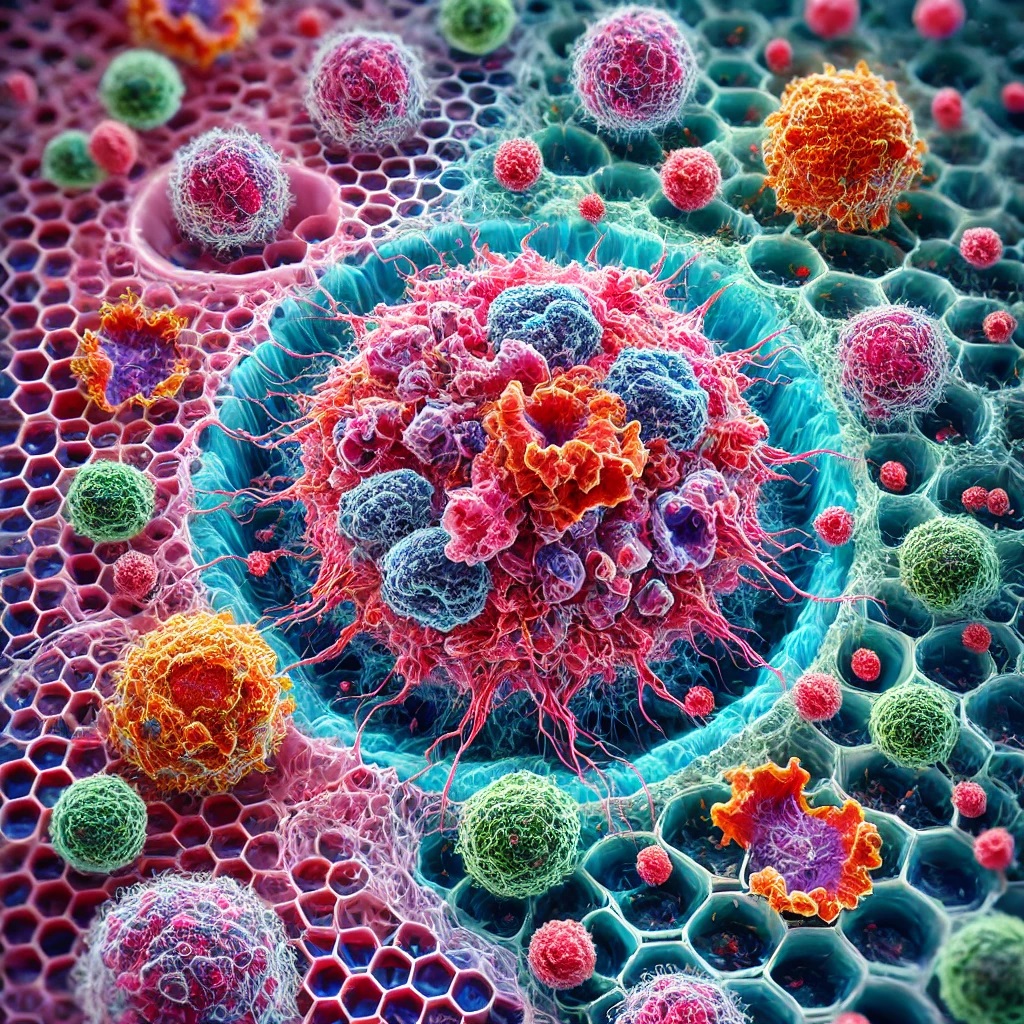Cancer: Human Health and Disease

Introduction
Cancer is a group of diseases characterized by uncontrolled cell growth and spread to other parts of the body. The term “cancer” encompasses more than 100 different types of diseases, all of which result from abnormalities in cellular mechanisms that regulate growth and division. Unlike normal cells, which have a limited lifespan and function, cancer cells can evade the body’s defense mechanisms, resist normal cell death processes, and spread aggressively. In this article, we will explore the various types of cancer, the mechanisms that drive cancer formation, risk factors, the process of diagnosis, and current treatment methods. Understanding cancer from a biological, clinical, and social perspective is crucial for its prevention, treatment, and overall management.
What is Cancer?
Cancer arises when cells begin to divide uncontrollably and avoid the normal mechanisms that regulate cell death (apoptosis). Typically, a healthy cell goes through cycles of growth, division, and death. However, in cancer cells, mutations occur in the DNA that affect the genes responsible for cell growth and division. This leads to the formation of a mass of abnormal cells known as a tumor. Tumors can be classified as either benign or malignant:
- Benign Tumors: Non-cancerous growths that do not spread to other parts of the body.
- Malignant Tumors: Cancerous growths that invade nearby tissues and can spread to distant organs through a process known as metastasis.
Mechanisms of Cancer Development
Cancer occurs due to a combination of genetic mutations, environmental factors, and lifestyle choices. The process of cancer development can be explained through several stages, which include:
- Initiation: The first stage involves a genetic mutation in a cell’s DNA, often caused by exposure to carcinogens like tobacco smoke, radiation, or certain chemicals.
- Promotion: In this stage, the altered cell begins to proliferate uncontrollably. The mutation may give the cell a survival advantage, leading to the accumulation of more mutations.
- Progression: As mutations accumulate, the cancer cells become more aggressive, growing rapidly and spreading to nearby tissues or organs.
- Metastasis: This is the final stage, in which the cancer cells break away from the original tumor and spread to other parts of the body through the bloodstream or lymphatic system.
The abnormal genes that cause cancer can be categorized into two types:
- Proto-oncogenes: These are normal genes involved in cell growth and division. When mutated, they become oncogenes and promote uncontrollable cell growth.
- Tumor Suppressor Genes: These genes normally function to suppress cell growth and promote cell death. Mutations in these genes can lead to their loss of function, allowing cancer cells to proliferate.
Types of Cancer
Cancer can develop in virtually any organ or tissue in the body. Some of the most common types include:
- Carcinomas: Cancers that begin in the skin or tissues that line internal organs (e.g., breast cancer, lung cancer, colon cancer).
- Sarcomas: Cancers that develop in connective tissues like bone, cartilage, or muscle.
- Leukemia: Cancer of the blood and bone marrow, characterized by the rapid production of abnormal white blood cells.
- Lymphomas: Cancers of the lymphatic system, which includes lymph nodes and lymph vessels.
- Melanoma: A type of cancer that originates in melanocytes, the pigment-producing cells of the skin.
Risk Factors for Cancer
Cancer development is influenced by a combination of genetic predisposition and environmental factors. Key risk factors include:
- Genetics and Family History: Some individuals inherit genetic mutations that increase their risk of certain cancers. These mutations can be passed down through generations. For example, mutations in the BRCA1 and BRCA2 genes increase the risk of breast and ovarian cancers.
- Tobacco Use: Smoking is one of the leading causes of cancer, particularly lung cancer. Tobacco smoke contains carcinogens that damage the DNA of cells in the respiratory tract, leading to mutations that may eventually result in cancer.
- Radiation Exposure: Ultraviolet (UV) radiation from the sun can cause skin cancer, including melanoma. Ionizing radiation, such as that from X-rays or radioactive materials, can also damage DNA and lead to cancer.
- Diet and Lifestyle: A poor diet, lack of physical activity, and obesity can increase the risk of several types of cancer, including colorectal and breast cancers. A diet rich in fruits and vegetables, regular exercise, and maintaining a healthy weight can lower cancer risk.
- Environmental Factors: Exposure to certain chemicals in the workplace or the environment, such as asbestos or benzene, can increase the risk of cancer.
- Infections: Some cancers are linked to viral or bacterial infections. For example, the human papillomavirus (HPV) can cause cervical cancer, while the Epstein-Barr virus is associated with certain types of lymphoma.
Diagnosis of Cancer
The process of diagnosing cancer involves several steps, including:
- Medical History and Physical Examination: A healthcare provider will review the patient’s medical history and conduct a physical exam to check for signs of cancer, such as lumps or abnormal changes in skin or tissue.
- Imaging Tests: Techniques like X-rays, CT scans, MRIs, and PET scans can help visualize tumors or abnormal growths inside the body.
- Biopsy: A biopsy involves the removal of a sample of tissue from a suspected tumor, which is then examined under a microscope to determine if it is cancerous.
- Blood Tests: Certain blood tests can help detect biomarkers or substances that are produced by cancer cells, such as prostate-specific antigen (PSA) for prostate cancer or CA-125 for ovarian cancer.
- Genetic Testing: In some cases, genetic tests can identify mutations or changes in the DNA that may suggest an increased risk of cancer.
Treatment of Cancer
Treatment for cancer depends on the type, location, and stage of the disease, as well as the patient’s overall health. The primary treatment options include:
- Surgery: Surgical removal of the tumor is often used when the cancer is localized and has not spread. Surgery may also be used to remove surrounding tissue or lymph nodes to prevent the spread of cancer.
- Radiotherapy: This involves the use of high-energy radiation to kill cancer cells or shrink tumors. Radiotherapy can be used alone or in combination with other treatments.
- Chemotherapy: Chemotherapy involves the use of drugs to kill or slow the growth of cancer cells. These drugs can target fast-growing cancer cells throughout the body but may also affect healthy cells, leading to side effects.
- Immunotherapy: Immunotherapy uses the body’s immune system to fight cancer. It may involve stimulating the immune system to recognize and attack cancer cells or using synthetic substances to enhance the immune response.
- Targeted Therapy: Targeted therapies focus on specific molecules or pathways that are involved in cancer cell growth. These therapies aim to block the action of molecules that promote cancer, with fewer side effects than traditional chemotherapy.
- Hormone Therapy: Some cancers, such as breast and prostate cancer, rely on hormones to grow. Hormone therapy involves blocking or lowering the levels of hormones to slow cancer growth.
- Stem Cell and Bone Marrow Transplant: For certain types of cancer, such as leukemia, stem cell or bone marrow transplants may be used to replace damaged or destroyed blood-forming cells.
Prevention of Cancer
While not all cancers can be prevented, there are several ways to reduce the risk:
- Healthy Diet: Eating a balanced diet rich in fruits, vegetables, and whole grains while avoiding excessive consumption of red meat and processed foods can lower the risk of cancer.
- Physical Activity: Regular exercise helps maintain a healthy weight and reduces the risk of cancer.
- Avoiding Tobacco: Quitting smoking and avoiding exposure to secondhand smoke can significantly reduce the risk of lung cancer and other tobacco-related cancers.
- Limiting Alcohol: Excessive alcohol consumption is linked to several types of cancer, including liver, breast, and colorectal cancer.
- Vaccination: Vaccines like the HPV vaccine can prevent certain types of cancers, such as cervical cancer.
- Regular Screening: Screening tests, such as mammograms, colonoscopies, and Pap smears, can detect cancer at an early stage when it is most treatable.
10 Questions with Answers related to Cancer and Human Health and Disease:
1. What is cancer?
Answer:
Cancer is a group of diseases characterized by uncontrolled and abnormal cell growth. The cancerous cells divide rapidly and may invade surrounding tissues or spread to other parts of the body, forming secondary tumors. This uncontrolled growth is usually due to mutations in the DNA that disrupt normal cell regulation.
2. What are the main types of cancer?
Answer:
The main types of cancer are:
- Carcinomas: Cancers that begin in the skin or tissues that line internal organs (e.g., lung, breast, or colon cancer).
- Sarcomas: Cancers that develop in the connective tissues such as bone, muscle, or cartilage.
- Leukemia: Blood cancer that affects the bone marrow and blood-forming tissues.
- Lymphomas: Cancers of the lymphatic system, including Hodgkin’s lymphoma and non-Hodgkin’s lymphoma.
- Melanomas: Cancers that start in melanocytes, the pigment-producing cells of the skin.
3. How does cancer develop in the body?
Answer:
Cancer develops when mutations occur in the DNA of a cell. These mutations can be triggered by various factors such as environmental exposure, inherited genetic factors, or random genetic errors. The mutations affect the genes responsible for cell growth and division, leading to uncontrolled cell proliferation. Over time, these cancerous cells can form tumors, spread to other areas, and evade normal cell death mechanisms.
4. What are proto-oncogenes and tumor suppressor genes?
Answer:
- Proto-oncogenes: These are normal genes involved in regulating cell growth and division. When mutated, they become oncogenes and promote uncontrolled cell growth, contributing to cancer.
- Tumor Suppressor Genes: These genes help regulate cell growth and repair damaged DNA. Mutations or deletions in tumor suppressor genes can lead to the loss of cell cycle control, promoting cancer development. An example is the p53 gene, which is often mutated in cancer cells.
5. What are the common risk factors for cancer?
Answer:
Common risk factors for cancer include:
- Tobacco use: Smoking and chewing tobacco are linked to lung, mouth, and throat cancers.
- Radiation: Exposure to ultraviolet (UV) rays from the sun and ionizing radiation increases the risk of skin cancer and other types.
- Diet and obesity: A diet high in fats and low in fruits and vegetables, along with obesity, increases the risk of colorectal, breast, and other cancers.
- Family history: Genetic predisposition can increase the risk of some cancers, such as breast cancer.
- Infections: Certain viral infections like human papillomavirus (HPV) and Hepatitis B or C can increase the risk of cervical and liver cancer.
- Environmental exposure: Exposure to carcinogens in the workplace, such as asbestos, can increase cancer risk.
6. How is cancer diagnosed?
Answer:
Cancer diagnosis involves several methods, including:
- Physical examination: Doctors may find lumps or abnormalities through routine exams.
- Imaging tests: X-rays, CT scans, MRIs, and PET scans help detect the size and location of tumors.
- Biopsy: A tissue sample is taken from the tumor and examined under a microscope to determine if it is cancerous.
- Blood tests: Some cancers can be detected through blood markers or abnormal levels of substances released by tumor cells.
- Genetic testing: Can identify mutations in genes associated with cancer risk.
7. What are the common treatments for cancer?
Answer:
Common cancer treatments include:
- Surgery: Removing tumors or cancerous tissue surgically, especially when it is localized.
- Chemotherapy: Uses drugs to kill or stop the growth of cancer cells. Chemotherapy can affect both cancer and healthy cells.
- Radiation therapy: Uses high-energy radiation to target and destroy cancer cells.
- Immunotherapy: Boosts the immune system to fight cancer by stimulating the body’s immune response.
- Targeted therapy: Uses drugs that specifically target cancer cells’ molecules involved in growth and spread.
- Hormone therapy: Blocks hormones that promote cancer growth, used mainly in cancers like breast and prostate cancer.
- Stem cell transplant: Replaces damaged or destroyed bone marrow with healthy stem cells, used in cancers like leukemia.
8. What is metastasis?
Answer:
Metastasis is the process by which cancer cells spread from the primary tumor to other parts of the body. The cells break away from the original tumor, travel through the bloodstream or lymphatic system, and form new tumors in other organs or tissues. Metastasis is a key characteristic of malignant cancers and significantly complicates treatment and prognosis.
9. What is the role of immunotherapy in cancer treatment?
Answer:
Immunotherapy is a treatment that uses the body’s immune system to fight cancer. It can involve using synthetic substances to enhance immune responses or introducing immune cells that specifically target cancer cells. Some immunotherapies include checkpoint inhibitors, which block proteins that prevent immune cells from attacking cancer, and CAR-T cell therapy, where a patient’s T cells are modified to better target cancer cells.
10. How can cancer be prevented?
Answer:
While not all cancers are preventable, several steps can reduce the risk:
- Avoid tobacco: Quitting smoking and avoiding exposure to secondhand smoke reduces the risk of lung and other cancers.
- Protect from sun exposure: Using sunscreen and avoiding tanning beds reduces the risk of skin cancers.
- Healthy diet and regular exercise: A balanced diet and physical activity reduce the risk of obesity-related cancers like colorectal cancer.
- Limit alcohol consumption: Reducing alcohol intake decreases the risk of liver, breast, and other cancers.
- Vaccination: Vaccines like the HPV vaccine can prevent cancers linked to viruses, such as cervical cancer.
- Routine screening: Regular screenings for breast, cervical, and colorectal cancers can detect abnormalities early, when treatment is more effective.






